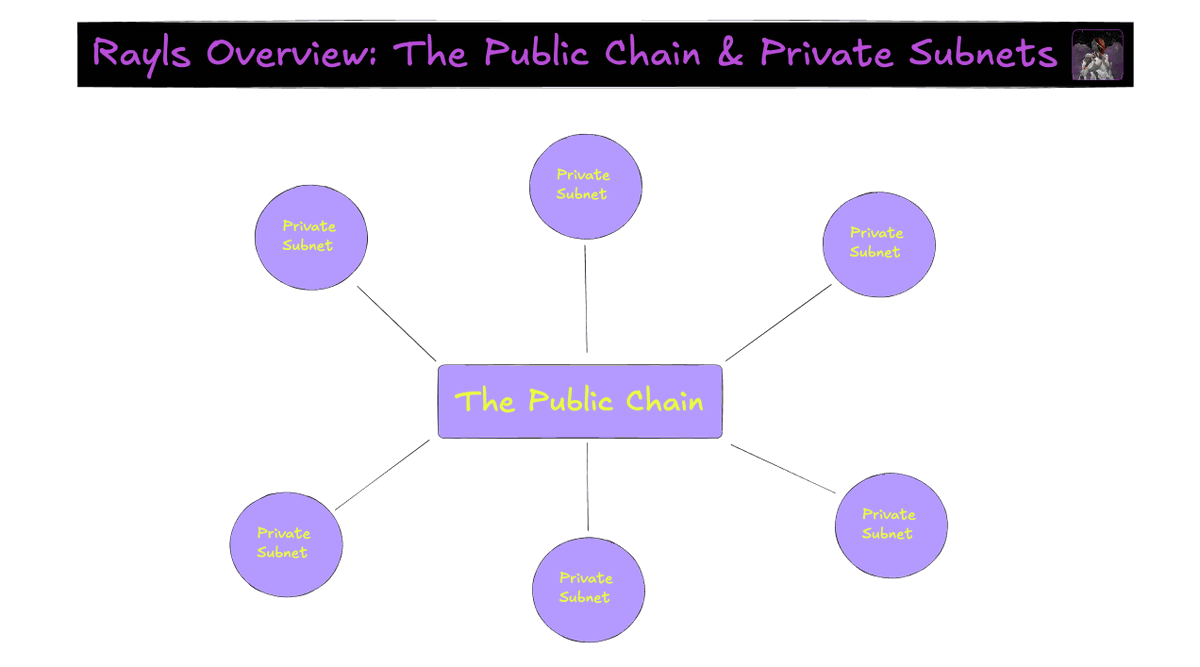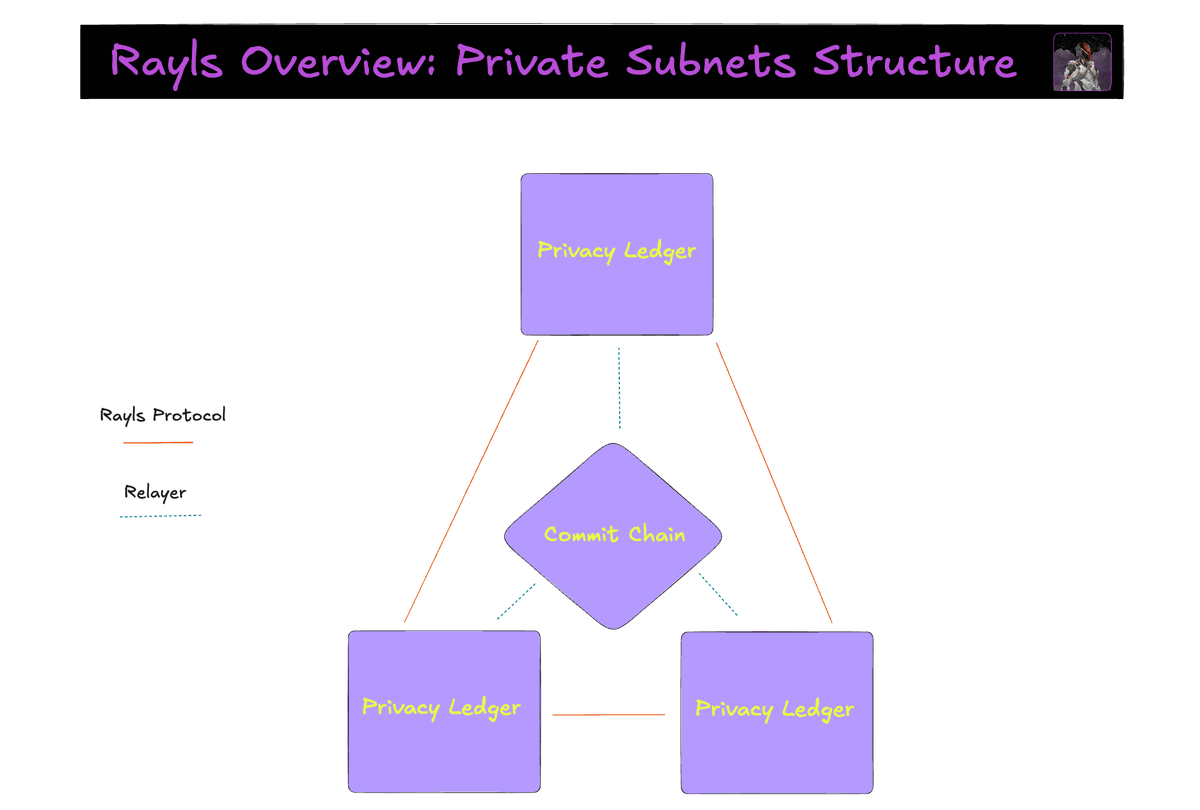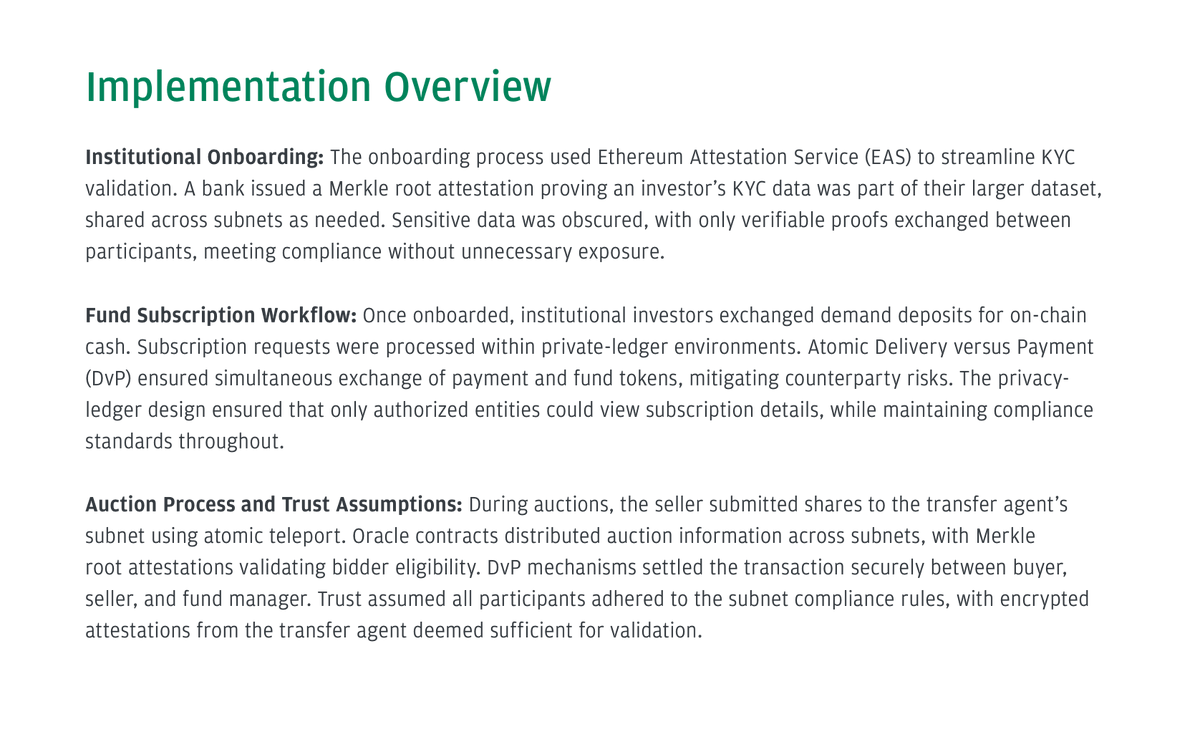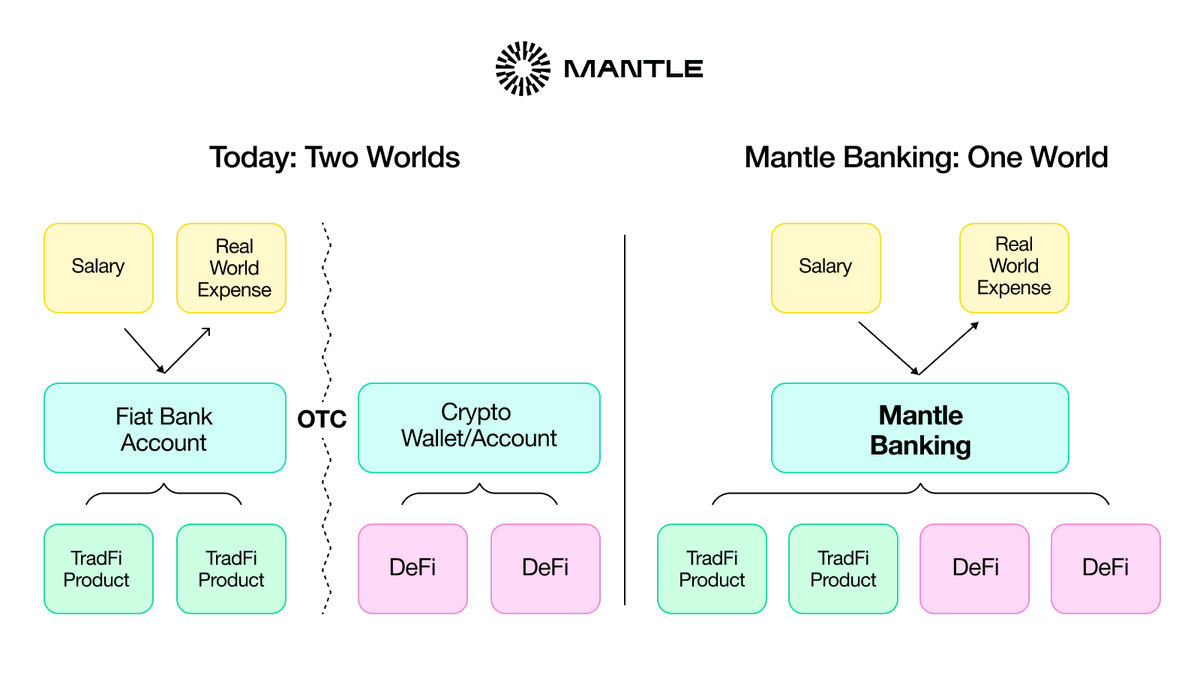没有 RWAs 的 DeFi 将会消亡。
但 RWAs 不会在没有 tradFi 的情况下增长。
我们需要量身定制的基础设施。
然而,DeFi 和 tradFi 是截然不同的世界。
DeFi 的可组合性和 tradFi 的合规性是两个难以结合的概念,但 @RaylsLabs 正在尝试通过其 UniFi 区块链来实现这一目标。
Rayls 结合了许可和无许可的基础设施,提供符合机构要求的解决方案,同时不牺牲开放 DeFi 生态系统的优势。
与本系列的前几部分一样,让我们先深入了解技术,以理解生态系统如何运作。
⚙️ 技术
Rayls 正在构建一个由不同网络组成的生态系统,这些网络相互封装并互联。基础设施由四个主要部分组成:
1.) 公链
2.) 私有子网
3.) 提交链
4.) 隐私账本
让我们深入了解每个组件 👇
1.) 公链的关键点
Rayls 的公链是由 @arbitrum 提供支持的以太坊 L2,要求所有用户进行强制 KYC。
KYC 过程通过开放银行 API 来验证用户数据,同时保护他们的隐私(没有数据存储在链上或链下)。
尽管受到 KYC 限制,该链将是无许可的,并与 DeFi 的其他部分互操作。用户和开发者可以像在任何其他生态系统中一样启动和使用应用程序、代币等。
通过这种设置,由于所有用户都经过 KYC,机构将更愿意与他们和生态系统中的 DeFi 协议进行互动,从而为新的资本和需求流入链上解锁许多机会。
2.) 私有子网的关键点
围绕公链,将有多个私有子网,这些是为机构量身定制的许可网络。
每个私有子网由以下组成:
• 提交链(中心)
• 许多隐私账本(辐条)
最后,每个子网都连接到主要的 Rayls 公链。
一个有趣的功能是,当创建一个子网时,会分别分配一个治理者和一个审计员来管理和监督它。
• 治理者 - 管理治理规则并改变子网的运作方式。
• 审计员 - 监控交易活动(通过提交链而不是在隐私账本内的交易)并向治理者报告任何可疑情况。
(查看图片 n°1)
3.) 提交链的关键点
提交链是每个私有子网中心的 EVM 兼容链,负责协调隐私账本之间的所有转移。
这是通过利用 Rayls Relayers,一个隐私保护的消息层来处理隐私账本和提交链之间的通信和转移。
通过确保所有交易都被中继、验证并完整记录,Relayer 在维护子网内的信任和可靠性方面发挥了关键作用。
想象一下这样的结构:
提交链 <> 中继器 <> 私有账本
(查看图片 n°2)
4.) 隐私账本的关键点
最后一块拼图是隐私账本,它们可以相互发送和接收代币。
Rayls 正在构建生态系统,以确保所有交易都被加密并对子网中的其他参与者隐藏。
这使得机构能够为其客户创建账户、发行代币并与其他机构进行交易,全部在完全隐私的情况下进行。
在这种情况下,子网内隐私账本之间的互操作由 Rayls 协议处理,这是一个端到端的私人转移解决方案。
想象一下这样的结构:
隐私账本 ⇄ Rayls 协议 ⇄ 隐私账本
(再次查看图片 n°2)
📈 机会与用例
1.) 有一个具体的机会可以看到现有和新协议与 TradFi 玩家合作,并在其子网内部署量身定制的应用程序。
这将需要团队与这些实体密切合作,并可能投入比在其他链上部署更多的资源,但收益可能超过努力,因为他们将能够访问一个独特的客户和流动性池。
2.) 第二个具体用例是一个多 CBDC 支付基础设施,其中不同的政府设置一个子网或多个子网,由银行作为结算和协调方。
这一模型在过去几个月的 PoC 中进行了探索,并在 2024 年 10 月发布的 G20 TechSprint 报告中进行了介绍。
🌎 LATAM 扩展与机构采用
@parfin_io,Rayls 的母公司,与南美的企业和机构有着密切的联系,这促进了 Rayls 在最近几个月的多个 PoC 和机构测试中的使用。
Rayls 参与的关键举措包括:
1.) Drex - 巴西 CBDC
Rayls 被巴西中央银行(Bacen)选为 Drex 的隐私解决方案,这是该国的官方 CBDC。
“对于任何代币化资产过程——代币化资产,我们指的是任何可以产生价值的东西——结算交易是至关重要的。要结算,需要法定货币,而要在区块链技术中使用法定货币,它也必须被代币化。”
该举措涉及 16 家银行、巴西中央银行和 Rayls。根据团队的说法,至少有五家机构继续测试并参与其基础设施。
对于银行和金融机构来说,CBDC 对传统收入来源如交易费用和价差构成挑战。银行可能会转向提供交易基础设施或代币化资产的流动性桥梁,而不是作为中介。
测试的关键亮点是:
• 金融机构之间的 Drex 转移
• 金融机构客户之间的代币化 Real/Drex 交易
• 金融机构之间的联邦公共证券(TPFt)代币化交易(DvP 方法 - 交付与支付)
• 金融机构客户之间的 TPFt 交易(DvP)
2.) 巴西最大的金融科技基础设施提供商
背景介绍:Nuclea 是巴西最大的金融科技基础设施提供商。仅在 2022 年,该公司处理了超过 310 亿笔交易,总额超过 19 万亿雷亚尔(巴西 GDP 的两倍)。
Núclea 管理着巴西 100% 的发票注册和 90% 的借记和信用卡结算。
虽然关于这一主题的信息不多,但 Nuclea 正在探索区块链技术,特别是 Rayls,以推进其基础设施并探索代币化用例。
3.) J.P. Morgan 的 EPIC 计划
去年 11 月,在 J.P. Morgan 的区块链部门的一份报告中,Rayls 被强调为参与 EPIC 项目以探索为机构量身定制的隐私和身份解决方案的合作伙伴。
官方公告称:“在 Parfin 的实施中,Rayls 展示了一个安全和合规的全球机构交易系统。”
(查看图片 n°3)



Everyone is talking about RWAs.
But no one is speaking about the elephant in the room.
A $1.8 Quadrillion industry that only a few protocols are targeting.
In the third part of this series, we'll focus on @Mantle_Official, which is positioning itself as a "financial hub" at the intersection of Web3 and Web2 with its latest two products:
• Mantle Index Four (MI4)
• Mantle Banking
Before diving into them and into Mantle's vision, a bit of context:
⚙️ THE TECH
Mantle Network is an EVM-compatible Layer 2 that integrates @eigen_da for data availability and @SuccinctLabs for zero-knowledge proving to provide institutions with a scalable infrastructure to build on.
Both integrations were made this year and represent key steps in Mantle's shift from an optimistic to a zero-knowledge rollup.
The original OP Proposer was replaced with the new Mantle Succinct Proposer, responsible for submitting ZK proofs to Ethereum L1. In parallel, @SuccinctLabs's SP1 Prover Network was integrated to delegate more compute-intensive ZKP generation tasks to a professional network, thus enhancing the chain's performance and scalability.
One of the main upgrades was replacing the original OP Proposer with the Mantle Succinct Proposer, responsible for submitting ZK proofs of Mantle's state changes to Ethereum L1. In parallel, to handle more compute-heavy tasks while maintaining high performance, Mantle also integrated @SuccinctLabs’s SP1 Prover Network to delegate those tasks to its specialized network.
(See image n°1 for a breakdown)
About the EigenDA integration, previously used a custom solution built on top of EigenDA, while now it directly leverages EigenDA’s solution. This allows the chain to scale data availability further without compromising security.
Now that we've recapped how Mantle distinguishes itself from other networks, let's dive into the core topics of this piece.
🏦 MANTLE BANKING
Mantle Banking is a crypto neobank that lets you manage fiat and crypto in one account, making it easy to receive, spend, and invest in both.
The platform allows users to set up a Swiss bank account and receive a globally accepted virtual debit card.
While launching such a service isn’t very difficult, there are two recurring problems most startups in this vertical face:
1.) Third-parties Dependency
2.) Web3 <> Web2 Interoperability
1.) Third-parties Dependency
Most startups launching these products don't control the underlying infra and, therefore, have a weak position when it comes to customer acquisition costs (CAC) and Lifetime value (LTV).
This is because:
1. They pay fees to external providers (e.g., custodians, payment processors, offramps, bridges).
2. They rely on their rules, uptime, and costs.
Ultimately, these two aspects increase the cost of serving customers and lower margins.
On top of that, users expect everything in one place. If your platform doesn’t offer spending, saving, investing, borrowing, and so on, they’ll quickly move towards whoever provides all of these.
2.) Web3 <> Web2 Interoperability
The second issue is most crypto apps can't properly connect to traditional banks or brokerages.
From on-ramping limitations (high fees, geo limitations, etc.) to banks limiting you once you interact with crypto apps, the UX is horrible.
Mantle nails these two problems by owning all parts of the value chain, from the blockchain to the banking one. This allows them to customize each layer of the stack and stay competitive in the market.
The mantle team outlined how ultimately capturing salaries via direct deposit into their neobank is the objective they're working toward.
From there, the use cases would be many, such as:
• Swap & send fiat currencies (USD, EU, SGD, etc.)
• Pay across platforms and merchants
• Interact with Mantle's DeFi Ecosystem
(Check image n°2)
🌐 THE PAYFI VISION
• The global payments industry records an annual transaction volume of $1.8 quadrillion.
• Total revenue across the sector reached $2.2 trillion in 2023 and is projected to surpass $3 trillion by 2030.
• Cross-border payments exceeded $150 trillion in volume in 2023.
• Digital wallets account for over 50% of global e-commerce payments and are expected to rise to 60% by 2026.
This is the scale of the payments industry today. However, most of this value still moves on traditional infrastructure.
And that's where the concept of PayFi comes in.
PayFi, aka Payment Finance → the merge of stablecoins, tokenized assets, and DeFi with legacy payment rails.
PayFi is based on the principle of the Time Value of Money, the idea that a dollar today is worth more than its value in the future because it can be invested or lose value due to inflation.
I'm briefly outlining this because it's exactly where Mantle wants to position itself with the Banking platform.
We're entering the phase where CEXs, L1s, and L2s will scale from targeting traders and DeFi users to the masses. This won't be done by creating some crazy DeFi apps that most of the population wouldn't be able to understand but by serving them what they already use daily.
Onchain and offchain worlds are converging, with CEXs, ecosystems, and FinTech giants racing to capture their share of the pie.
📈 MANTLE INDEX FOUR (MI4)
Simply put, the yield-bearing S&P 500 of crypto.
MI4 is a tokenized fund that offers diversified exposure to yield-bearing assets, with @Securitize as the tokenization partner, @FireblocksHQ as the custody provider, and the Mantle Treasury as the main investor by committing $400M from its balance.
The reason MI4 is very interesting is its institutional-focused approach, as it provides a relatively low-risk, index-based product that’s familiar to traditional investors.
On top of that, it bakes in yield generation, making it even more attractive to asset managers and funds.
The yield comes from blue-chip staking strategies like:
• @mETHProtocol's mETH
• @Bybit_Official’s bbSOL
• @ethena_labs’ sUSDe
These allocations are rebalanced quarterly, and the current fund's structure looks like this:
• BTC - 50%
• ETH - 28%
• USD - 15%
• SOL - 7%
What's remarkable about MI4 is that it's @Securitize’s largest tokenized fund, demonstrating Mantle's commitment to attracting more institutional participation and expansion beyond a generic-purpose L2.
🌱 INITIATIVES TO DRIVE THE INDUSTRY FORWARD
Lastly, as we did in the previous pieces, it's worth mentioning the initiatives Mantle is carrying out to increase ecosystem adoption and global expansion.
1.) Mantle EcoFund - Launched in 2023, it's a $200M fund investing in startups building in the Mantle ecosystem. The fund is also invested in Synergy, a $5 million initiative in collaboration with TON Ventures to advance cross-chain developments between the two networks.
2.) LATAM Expansion - In partnership with @odisealabs, Mantle is engaging with local developers, entrepreneurs, and communities, providing resources and support to accelerate Web3 adoption across the region. This is also part of a bigger vision, in which LATAM will be a main propeller of Mantle Banking's adoption.


5.07万
34
本页面内容由第三方提供。除非另有说明,欧易不是所引用文章的作者,也不对此类材料主张任何版权。该内容仅供参考,并不代表欧易观点,不作为任何形式的认可,也不应被视为投资建议或购买或出售数字资产的招揽。在使用生成式人工智能提供摘要或其他信息的情况下,此类人工智能生成的内容可能不准确或不一致。请阅读链接文章,了解更多详情和信息。欧易不对第三方网站上的内容负责。包含稳定币、NFTs 等在内的数字资产涉及较高程度的风险,其价值可能会产生较大波动。请根据自身财务状况,仔细考虑交易或持有数字资产是否适合您。

